Key Takeaways
- Event planning involves detailed organization and management of various elements, including budgeting, staffing, venue selection, and sponsorship acquisition.
- Detailed budgeting is key, it involves precise planning for all expenses, including venue, catering, and marketing.
- Effective staff management ensures event smoothness. It requires clear roles and communication for efficient event execution.
- Venue selection hinges on size, accessibility, and amenities.
- Gaining sponsors demands identifying suitable partners and presenting a strong case.
- In event planning, Jotform’s specific features like online registration forms, RSVP tool, and feedback surveys are particularly beneficial. Additionally, Jotform Tables help in managing guest lists and schedules, while Jotform’s payment integration facilitates seamless handling of event-related financial transactions.
So you want to plan an event. Good idea!
A well executed event can bring in as much as $704 per participant. Even more important, it can introduce your organization to powerful sources of ongoing support, from newfound audiences to bedrock sponsors. And each successful event makes the next one more successful.
It’s not magic; it’s details.
Think about the last event you attended. How did you find out about it, and why did you go? Was it easy to get there? Was the location comfortable? Were you served food and/or drinks? What did you see and hear and buy and try? Who did you meet? Did you learn anything, enjoy yourself, come away with new contacts? Did it impress you? Was it worth it?
Everything that goes into making an event happen is the job of an event planner. Everything that goes into making it memorable is the job of an excellent one.
Like many things that require lots of work, events drive enviable results for businesses and organizations — which explains why 84 percent of leadership think that in-person events are a critical component of their company’s success.
So how exactly can you create events that deliver?
Checklist for becoming an event planner
Learn the ground rules
Get in the trenches
Plan your first five to 10 events
Build your brand
Never stop marketing
The touchstone of event planning is that you never launch an event without a clear plan for how it will run from start to finish. Simple as that sounds, it’s a foundational rule that guides all professional event planners.
There are several ways to learn the fundamentals of event planning. You can take a course, hire an event planner and pay attention to what they do, or pick up tips from successful event planning companies’ social media and blogs.
Eventbrite covers the basics and is a great resource for beginning planners, Eventtia can help you use technology to your advantage, and you’ll stay inspired by following Endless Events, which is best known for planning Comic-Con and The Color Run.
Of course, you could save yourself some time and money and use this event planning guide as a crash course.
In addition to learning event planning fundamentals, the sooner you can get some hands-on experience, the better. The ability to handle pressure and hit deadlines is key to success on every project, and there’s no substitute for real-world accountability.
You can get event planning experience through a mentor who’s an event planning veteran, by planning free or low-cost events for friends and family, and by volunteering at events where you can watch seasoned planners work their magic.
Make it a goal to plan your first several events within a defined period of time. This will keep you focused and serious about your event planning career.
A study by psychologist Gail Matthews showed that when people set goals, document them, and share them with friends, they’re 33 percent more successful in achieving them than those who have just a vague idea of what they want to accomplish.
In essence, goal setting spurs you to achieve actionable aims within a certain time frame. If you set specific goals going in, you’ll be better able to overcome inevitable distractions and obstacles and keep concentrating on getting closer to where you want to be.
Once you have some event-planning experience under your belt, it’s time to start building your brand. By now, you’ll be able to assure both yourself and any potential client that you can successfully plan an event.
Start by setting up your social media profiles and writing yourself a distinctive bio.
Develop conversational content about your event management experiences that you can share to establish authority in the industry and attract a following for your events. By offering appealing value out of the gate, rather than trying to persuade without a track record to back you up, it will be easier to get the attention of more promising clients.
You can’t market an event if you can’t market yourself. Begin with the basics, like business cards and a website, and let your personal connections know you’re launching a career in this industry and are available for hire or referral.
It’s worth planning a few small events for friends and family for just your out-of-pocket costs to get your feet wet and spot areas for improvement before you try to please bigger clients. This will also give you the chance to earn some word of mouth from everyone who enjoys your events (as a host or guest), which is always the most reliable way to get new business.
Once you’re confident in your skills and ready to tackle larger scale events, you’re ready to make use of social media, blogging, and newsletters to gain interest from those outside your immediate circle. Develop an authentic, personable, and distinctive voice that reflects your personality and emphasizes what sets you apart as a professional in your industry. And use this voice for all of your communications.
The easier it is for prospects to imagine what it will be like to work with you, the greater the chances they’ll try you out. And the more useful content you can provide through a slow but steady pace of posts, updates, and emails, the more people will understand and trust your approach and look forward to opportunities to apply your skills.
Now, how do you plan a successful event?
How to start planning an event
In this section, we’ll cover three key aspects of starting an event planning business:
- Steps for planning your first event
- Developing an event planning business plan
- General event planning software
Steps for planning your first event
You can break up the process for planning a successful event into six key steps:
Define the North Star Metric (NSM) for your event
Personalize your event activities for a specific audience
- Designing event flyers, emails, and so on, that align with New Yorkers and their culture
- Addressing issues specifically faced by event practitioners in New York
- Communicating before, during, and after the event using New York colloquialisms and slang
- Relating your event to a recent popular event in the city
Select your event team and contractors
- Do they have experience in event planning or management? What were their results?
- How did they handle their tasks? Watch out for problem solvers vs passive candidates.
- Can they handle pressure? Things move really fast at events, and each of your team members may have to regularly make on-the-spot decisions during the event. Event planning/management requires people who can work under pressure.
Choose a venue that aligns with your goal or NSM
- Accessibility
- Hotels
- Transit
- Amenities
- Capacity
Automate where possible
Market your event
Whether you’re planning on using the event to build thought leadership, to attract attendees for a show, or to generate leads and customers for your business, you need to be clear about the specific goal you’re trying to achieve.
This way, you’ll be able to direct your workforce and resources toward hitting that single goal. Think of your goal as what former Eventbrite growth executive Sean Ellis calls the North Star Metric (NSM) — the single metric that best captures the core value your product (event, in this case) delivers to customers (attendees).
For example, if your goal is to drive leads through an event, you need to tie the value you’re providing at the event to driving leads.
The value you provide at the event could be a free tool, for example. This value is your NSM; the more people demand it at the event, the better you achieve your lead generation goal — because the people who demand the tool become your leads.
Defining a specific NSM lays the groundwork for your event planning platform.
Fifty-one percent of consumers believe brands send them too much irrelevant content.
Your attendees want you to know who they are and to be aware of their specific needs. To attract them, create events that give them something of value (something they’ll have a hard time refusing).
For example, let’s say you’re organizing a meetup for event planners in New York City. Personalizing the event involves
In a world where people hoard and protect their privacy like it’s a million karat gold bar, 57 percent of consumers say they’re willing to share personal data in exchange for information (or some other value) you have that will improve their lives, if the offer is personalized. In essence, people love personalization. Your event is more likely to grab their attention when it’s personalized to them.
Zappos CEO Tony Hsieh estimates bad hires have cost the company “well over $100 million.”
Hiring the wrong people for your team can break your event before it even starts. Regardless of your event size, you need professionals assigned to every nook and cranny of your event-planning and management process.
From your event director or manager down to interns and volunteers, you need to hire the sharpest minds you can get and properly organize your team so you all can work seamlessly to achieve your event goals.
You, as the event director, are the one responsible for putting the right people in the right job. Once you do that, everything else is easy.
A great way to identify reliable team members is to look at their previous jobs:
In general, look for candidates who have strengths in the areas you need for your events. Before they start working, establish key performance indicators (KPIs) for them so they know exactly what you’re looking for.
You have a goal for every event, and your event venue must align with it — or at least shouldn’t hinder you from reaching it.
Here are a few things to look out for when shopping for the right event venue:
Your event venue should be located near your anticipated attendees. If most of them are in New York, for instance, setting up in California doesn’t make much sense, as it would require significant travel on top of the expense of registering for the event itself.
If, however, your event regularly attracts attendees from out of town, then it’s important for you to get hotels in the area prepared for them.
Make arrangements with local hotels and book rooms in advance if possible. You can probably get discounts by booking in bulk. While marketing the event, inform potential attendees that hotels are available if they’re coming from far away.
Guests can’t attend your event if they can’t get there. It’s ideal to choose a venue close to public transportation, to welcome those without a car, make any alcohol consumption at the event safer, and show a commitment to environmental consciousness.
It’s also important to offer secure parking for guests who prefer to drive. Designated parking in a guarded lot will help guests relax and enjoy themselves, and shows an attention to detail that elevates the sophistication of your event and the credibility of your organization.
Most event venues provide you with the spaces and stages to make your event happen. But some may provide unique benefits that will further help you achieve your specific goals.
Some venues not only provide the use of a kitchen but also include catering for your event for a down payment and price per attendee in lieu of a facility fee. There may be tables, chairs, and linens available for your use, so you won’t have to budget and figure out the logistics for these essentials.
It’s also smart to investigate whether the venue has audiovisual equipment onsite, which can save the money, time, and hassle of procuring your own or fitting what you have to the particulars of the space. Perhaps most enticing, if the venue offers a crew to set up and clean up, you won’t need to enlist volunteers or hire people to cover this necessary chore.
How many people are you inviting to your event? What if everyone comes? It’s important to be sure your venue can accommodate maximum capacity, in case your marketing efforts are especially effective.
Event planning is the sixth most stressful job in the U.S. You need to manage your time and energy.
The more tasks you can automate, the faster you’ll be able to get specific jobs done and improve the experience of your event attendees — 88 percent of event professionals said using an event app had a positive impact on attendee satisfaction, a key metric.
Once you’ve planned your event, it’s time to get the word out. Social media campaigns are the latest and greatest way to market; in fact, 84 percent of event planners rate social media campaigns as important or very important for event marketing. Posting to your networks and encouraging your event partners and vendors to do the same is vital to raising awareness and sparking anticipation.
Instagram and Facebook can make it easy to run event-themed contests or giveaways leading up to launch, attracting attention, getting involvement early, and inspiring excited attendees to do their own marketing for you.
If you can bring a blogger or influencer on board, all the better, as the fastest way to expand your audience is to borrow a bigger one. Even a slight sheen of celebrity can help, giving an impression of exclusivity while actually growing your guest list.
That said, you may get the highest rate of return by emailing existing contacts. Forty percent of respondents to a survey conducted by Bizabo think that email marketing is the most effective channel to promote an event. Plan ahead so you can send multiple invitations and reminders, starting with a “save the date” announcement and gradually increasing the frequency of emails until the day of the event.
Offering your email list a discount, add-on, or special access will make your existing audiences, who are already the most likely to be interested, feel like insiders and can increase your signup numbers. These are also the guests who are most likely to invite friends or friends of friends to join them, extending the reach of your marketing efforts.
Don’t forget to integrate compelling imagery, a link to a dedicated landing page on your site with all relevant event information, and, if you have them, testimonials from past attendees, so recipients will have everything they need to take the leap and register for your event.
There you have it: six key event planning tips that can help you plan events that linger in the hearts and minds of your attendees.
Developing an event-planning business plan
No one goes to war and fights confidently without a plan. The same idea applies to starting an event-planning business (or any business, for that matter). It may not be war, but there is heavy competition. In the U.S., for instance, there are more than 140,000 event-planning businesses — and in the last five years, the industry has grown by 2.9 percent.
It’s probably no surprise that clients give their event planning gigs to event management businesses they trust. So if you’re going to succeed in the midst of the thousands of event planners in your region, you’ll need a business plan.
Your business plan should include the following:
- Summary: Overall information about your business
- Objective: What’s your aim for the business? Or how do you plan to help people with your craft?
- Services/products: What are the exact services and products you’re offering?
- Structure: Are you planning a sole proprietorship, a partnership, or some other structure?
- Target market: Who are your target clients? Wedding celebrants? Corporate business? Artists (musicians, etc.)?
Now, let’s discuss event tech.
General event-planning software
Two things will make life as an event planner easier for you:
- Getting super organized.
- Saving as much time as you can.
There’s little chance you can pull off these two tasks without good event-planning software.
Look at the pros and cons of each tool. Do they have features that support the specific event you’re planning? What’s their ticketing system like? How do they help you follow up with registered attendees? Do their fees mesh with your budget? Are they mobile-friendly for you as the organizer and for event attendees? And so on.
To ease your search for the right event planning software, here are four tools you can choose from:
Jotform
With Jotform you can create a low-cost event registration form. Before, during, and after you’re done planning your events, you’ll need to collect a few bits of information from stakeholders, partners, attendees, and workers. Jotform helps you build forms, which you can fully customize to collect as much information you need to make your event successful.
Pricing is free to $82.50/month.
Eventbrite
Eventbrite is one of the most popular event management tools out there, and for good reason. It allows your attendees to register via their mobile phones and sends them follow-up notifications. And event planners can run, promote, and track their event from their mobile device.
Their fees start at 2 percent + $0.79 for each paid ticket.
Bizzabo
Bizzabo is another popular event tool. It helps you interact with your attendees from registration to the time of the event. With it, you can create a landing page that contains all the information your attendees need and persuades them to click the registration button.
Bizzabo offers three pricing plans — Planner, Pro, and Elite — but you have to contact them to learn the details.
Planning Pod
Planning Pod gives you an arsenal for event registration: RSVPs, check-ins, web pages where your attendees can get detailed info, tasks, calendars, time lines, budgets, forms/surveys, and vision boards as well as at-a-glance dashboards and reports. Their overall rating, according to Capterra, is 4.5 stars.
They currently charge on a monthly basis, and their fees start at $19 per month.
How to budget for an event
Regardless of whether you have $5,000 for a small event or $1 million for an international conference, bad budgeting can squander the money placed in your care as an event planner.
How to draft an event budget
In most cases, you can keep it simple. Basically, you need these four elements in your event budget template:
- Items. The items you need to run the event, like chairs, tables, microphones, speakers, performers, and so on.
- Description. Once you’ve identified the items you need, describe them in your budget so it’s easy for your client (or whoever you report to) to understand the relevance of each item.
- Quantity. How many of the items in your budget do you need for the event? How many chairs, speakers, etc., do you need?
- Cost. What is the total of each of these items? You need to include the unit cost of each item and their collective costs — as well as your estimated and actual costs.
For example, how much do you expect to spend renting chairs? And how much do 120 chairs go for? Once you find out the actual costs, you need to reconcile them in your budget draft as well — for the purpose of transparency between you and your client or boss.
Examples of event budgets
Here’s how all of that event budgeting information looks on paper:

You can easily create this in a spreadsheet, if that works for your specific event. But if doesn’t, then you need to use an event budgeting software tool.
Event budget software options
Here are three event budget software options you can use:
Aventri
Aventri helps you track your event expenses and revenue (if your event is a money-maker). The tool helps you manage your budgets from their estimated, approved, and actual stages. You also get to see reports of various events and compare their costs and key metrics.
Grenadine Event Software
Grenadine Event Software is another tool that helps you manage your budget throughout an event planning cycle. It lets you track payments, expenses, and revenue from your events in multiple currencies.
With Grenadine, you can create budgets for revenue from your event in areas like registration fees and ticket sales, sponsorships and grants, exhibit booth sales, special functions fees, advertising revenue, and much more.
You can also track event expenses like accommodation fees, event administration costs, electrical and lighting rental, and entertainment expenses.
Cvent
Cvent helps you track funds, recalculate variable costs, and monitor budget surplus. With Cvent, you can generate event reports to demonstrate the ROI and key metrics of your events to clients or employers.
Managing event staff
Eighty-six percent of consumers are willing to pay more for an upgraded experience. But you’ll find it hard to create that type of experience at your event with poor staff management.
You need a team you can rely on. Once you’ve assigned everyone their jobs and told them what to do, you should be able to rest easy and focus on other things.
But that doesn’t always happen. For almost every event you plan, you’ll have workers who don’t interpret your instructions properly, make a bad decision, miss important deadlines, or drop the ball in some other way.
Any mismanagement of this sort can mess up your event fast. But don’t worry; there’s hope. Managing event staff is a skill you can learn.
There are two key elements that come into play before and while working with your event staff:
- Hiring the right candidates
- Managing your event staff effectively
Let’s look into both.
Hiring the right staff for your event
It’s important to hire the right people. Here are a few tips to identify the right staff for your event planning team:
- Identify the skills you need. Put a finger on the exact skills you need your event staff to have to work effectively at your event(s). Ideally, you should start with contractors. As your event company grows, you can begin hiring full-timers.
- Publicize your hiring needs. Put the word out about your hiring needs. Ask your connections if they’ve worked with people who have skills similar to those you need. Post your job ad on online job boards and share it with the associations and social networks you’re part of. These should drum up a few good candidates.
- Your ideal candidates should prove themselves. Once you start getting applicants, your ideal candidates should have examples to prove their expertise or at least be able to defend it in an interview.
- Put candidates in the trenches. Experience is the ultimate test of knowledge. While interviews may give you theoretical information about your candidates, you won’t know they’re a good fit until you put them on the job. If possible, agree to pay for their services for one event and see how they perform.
In general, you can identify your ideal candidates by asking them the right questions. Use one of Jotform’s job application forms as a time-saving first step, so you can assess at a glance whether a candidate is qualified. By standardizing the application process, you can compare applicants more accurately and quickly determine who should move on to the next stage of the hiring process.
Managing your event staff effectively
When all is said and done, and you’ve staffed your event with the best people, here are five key event staff management strategies you should use:
Make your instructions and goals clear
Set time frames and deadlines
Implement a workflow management system
Create an open line of communication
Properly brief your workers, and make your goals clear. Before sending them to an event, ensure you’re all on the same page regarding each of their tasks.
For example, if you need your caterer to serve attendees on a certain side of the hall first, followed by attendees in the middle of the hall, and then those on the other side of the hall, make this clear. If you need to write these instructions down on paper, do it. You probably know this already, but a simple instruction carried out in an unplanned way could lead to a crisis that disrupts the entire event.
When do you need your tasks completed? Everyone from your cleaners to your MC should know when you expect them to complete given tasks. These time frames and deadlines help your team members cut out distractions, remain focused on their jobs, and stay productive.
As the name implies, a WMS is a tool that helps you streamline your work processes. WMSs save you a ton of time.
Once you have your processes documented in a WMS like Trello, for instance, invite your team to it so they’ll all be fully aware of what to do and how to do it.
This saves you a lot of time and stress in explaining your processes to new hires or at every new event. No wonder 50 percent of businesses that use workflow management systems say the results are substantial.
Your staff — regardless of how experienced they are — might have to contact you just before, during, or right after your events.
You need to set up a system so that they can always reach you when they need to. Slack is a great option. Whether your workers need to get on a call with you during the event, share a document, or alert you when there’s some top priority and impromptu decision to make, Slack is a tool that ensures you all have an open line of communication.
How to select a venue for an event
A great venue is inarguably a cornerstone of any successful event, so you have to choose yours wisely. You should pick a venue that suits your type of event and helps you achieve your event goal.
How do you do that?
Do your research
Negotiate
Sign an agreement
Once you know the location where you’ll hold your event, it’s time to assess venue candidates so you can compare the ones you like and choose the best fit. After you’ve identified several venues that are the right size for the number of guests you expect and within your budget, see how their nuances stack up so you can narrow your choices.
Is the venue ADA compliant so all your guests can attend? How much liability insurance are you required to carry to book the venue? How do the acoustics, ambiance, and architecture affect how it feels to be in, talk in, listen in, and move through the space?
Depending on whether your event is a formal gala, a trade show or expo, or a high-tech presentation, you’ll need a particular kind of place to make guests feel welcome and ensure the event flows smoothly. The character of the space should fit the feel of the experience you plan to create, and the only way to know if it does is to visit.
Find out online or from other event planners how much the type of venue you need generally costs. That will give you an idea of how much to budget.
Regardless of how much your chosen venue wants to charge you — whether more or less than your budget — feel free to negotiate. You can often secure your venue at a cheaper price and use the surplus in other areas. Your clients or boss will appreciate you for it, and that can increase your chances for more event planning business in the future.
You don’t really have a venue until you have it in writing. That means a signed agreement that details the responsibilities of both parties, so there’s no risk of misunderstandings.
Your contract should specify the date of your booking, but be sure it also clarifies the exact hours you’ll be able to access the space, when you can start moving supplies into the space, and when you need to be completely out.
In addition to the cost of your rental and the deposit to hold the space, look for a payment schedule with dates and amounts, as well as refund and cancellation policies. Check for any restrictions on noise, flames, or decor, and whether you have to use particular vendors.
What happens if damages occur during the event? Is a sound or lighting system, heating and cooling, kitchen, catering, or DJ equipment included in the price?
In the unlikely event the venue doesn’t have a standard contract, create one of your own so you can be sure you have your terms in writing and can budget appropriately.
But before you make it official, do a little extra legwork to cover all your bases.
Before you book
Here are a few key factors to consider when booking a venue:
Check reviews
Focus on the details
- Reputation. Get an idea of the reputation of your event venue. Ask around to see if the venue managers change after collecting booking payments. Do they become less accessible, or can they be trusted to remain a resource throughout your event?
- Flexibility. What happens if you use overtime in the facility? How flexible are they when things don’t go exactly according to plan? You need to know how your event managers react to unforeseen circumstances (which are likely to happen in most of the events you plan).
- Staff. Who handles things like cleaning, security, etc.? You need to know which workers you’ll have to hire and which the venue will provide.
- Site. Go to your event venue’s website homepage, About page, and Services page to look for anything you might find troubling (how professional does it look?) or can take advantage of (like lower rates for certain dates and times) before you book. An FAQ page can show some shortcuts to answers you need, but be sure to confirm any details with venue management.
Know if there are extra costs
There’s a reason 91 percent of 18–34-year-old consumers trust online reviews as much as personal recommendations. It’s because they want to learn about other people’s experiences with the brand they’re planning on doing business with.
You need to check online reviews for the same reason. A quick Google search on any event hall/center can show all the reviews you need.
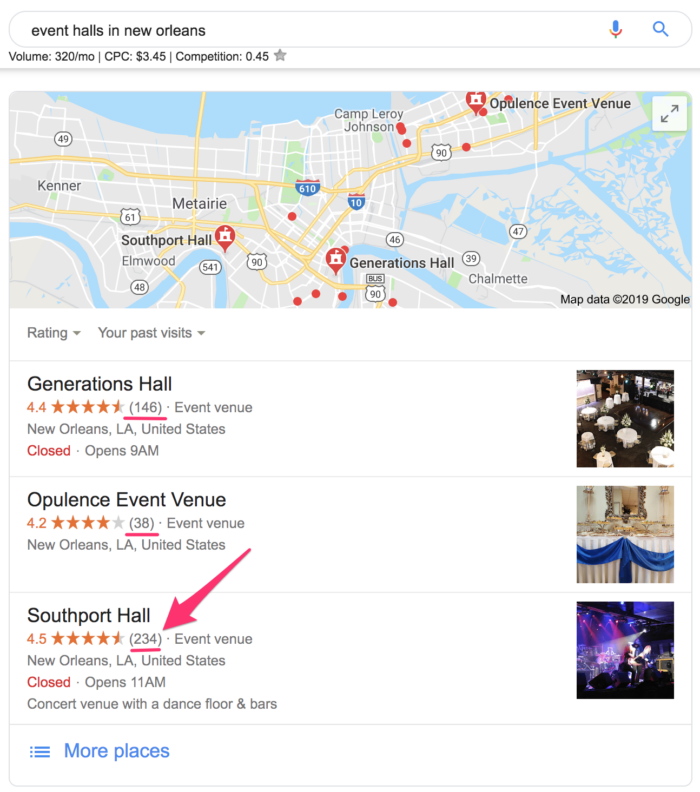
The search results also show the number of reviews each event venue has. You can click through the options to see what people are saying about the venues. Ideally, choose a venue with an average four-star review and features that suit your event.
As the saying goes, “The devil is in the details.”
A newbie event planner may think selecting a venue is nothing more than picking a location that suits their event style and budget. But an experienced manager knows they need to be more detailed than that.
Here are a few important details to watch out for when booking your event venue:
You don’t want to be surprised with last-minute unexpected expenses. An experienced event planner will think ahead and include contingencies in the budget (usually three to 10 percent of total costs), so no matter what happens, they’ll be covered.
Directions given in the heat of the moment can quickly rack up additional costs you’ll pay later, from rush printing fees to corkage to credit card processing to shipping or airline transactions. If you forget to calculate them ahead of time, housekeeping and resort fees can catch up with you too.
Are you paying onsite staff by the hour, and do you need them to work overtime? Will you be charged extra for walk-ins? What tips or taxes are you paying, and to whom? Are trolleys or buses already billed as part of the venue pricing package, or do you have to handle your own wheels? Overall, it’s essential to know exactly which pieces of equipment will be provided and which you’ll have to bring.
How to get sponsors for an event
Every event needs sponsors. As an event planner, it’s your job to find them.
The arrangement may seem one-sided, but you actually have something potential sponsors want: exposure. If you can find the right fit with the right companies, they’ll gladly support your event (in other words, pay you money) in exchange for your promotion. The trick is to convince them that the brand awareness you can offer is the kind they’re looking for.
Here are three key steps you need to prove to future sponsors that your event is right for their audience:
Identify your ideal sponsors
Call for event sponsors
Sell the right benefits
First things first. Your ideal sponsors are brands that will directly benefit from your audience and be most recognizable to them.
For instance, if you’re hosting a healthy lifestyle themed event, it’s smart to reach out to brands with a similar ethos, whether they make clean food, low-sugar treats, crystal jewelry, air or water filtration systems, or fine home goods from organically farmed natural fibers. Steer clear of, say, a fast food, pharmaceutical, or automotive sponsor, no matter how deep their pockets.
Alignment in mission, brand personality, and customer benefit are crucial commonalities that will not only make the organizations you approach more likely to take on your event, but can strengthen your own brand as you promote theirs.
Another way to choose a sponsor is to be strategic about the kind of support you need the most to make your event a success. If you’re planning a high-profile event featuring celebrity speakers, a media sponsor will naturally amp up your coverage, whereas if you’re launching a new event that could use a bigger guest list, sponsorship by an established company or popular influencer can draw crowds.
If you’re concerned about your budget, donations from larger corporate sponsors can make it possible for you to integrate wishlist extras like apps and special guests, whereas a local hospitality or transportation sponsor can cover key logistics and lower your expenses. Think about what best fits your company and your event, and seek your sponsors accordingly.
Besides reaching out to potential partners, you can also make an announcement and ask them to come to you. This works best when you’re organizing an event that has been successful in the past, as sponsors will be eager to associate with a well-known event that can boost their image.
Create a web page that explains who your audience is and what sponsors stand to gain by partnering with you. Make it easy for them to sign up and contact you. Use a form to request all the details you need from them; the Jotform sponsorship request form is a great option, and is fully customizable so you can add and remove elements as needed.
Before reaching out to a potential sponsor, research their product and primary and secondary audiences.
Once you’ve defined their customer base, map out how you plan to help sell your sponsor’s products to them. It will be much easier to sell them on sponsoring you if you keep this the focus of your proposal, because it shows you’re prioritizing their concerns and clearly specifies the value they’ll get from your event.
When in doubt, stick to the facts. Your proposal should detail the purpose and nature of your event, outline its history (if it has one), include relevant analytics regarding attendees and how you predict your event will influence their behavior, and the specific ways you envision your partnership benefiting your sponsor. If you can make a clear and convincing case for what’s in it for them to join forces with you, your request will start feeling like an opportunity.
Examples of different outreach strategies
Once you know who you want to approach and why, you’re ready to start an outreach campaign to potential sponsors.
You can probably guess the basic strategies for contacting possible partners:
- Cold calling and introducing yourself
- Emailing an unsolicited pitch
- Arranging an introduction through a mutual contact
“Brands — especially big name brands — receive up to 10,000 unsolicited sponsorship proposals a month,” says The Sponsorship Collective CEO Chris Baylis.
This means you need to map out an event sponsorship strategy that’ll make your proposals stand out from those of other event organizers and go beyond the basics.
You can do this by
- Asking for a low-budget sponsorship. This works especially well if your event or brand isn’t very popular yet because it helps persuade your potential sponsors to come on board because their risk is low.
- Offering a unique and valuable incentive. If you ask for a low-budget sponsorship with a great incentive that many other events won’t offer, you’ll have a leg up. For example, you can offer to get the potential sponsor hundreds of leads (names and emails of their target customers — your attendees). This allows you to promise sponsors a high ROI if they’re a B2B brand since they probably spend way more than what you’re asking to generate leads elsewhere.
- Partnering with brands your potential sponsors admire. It’s a no-brainer. If there are brands (and there are) your potential sponsors admire in their industry, find a way to partner with those brands; it will be much easier to sell sponsorships this way.
- Being flexible. Ask potential partners what they would like to get out of the event. This creates a win-win situation for both parties. And if they propose an option too different from your goal, you can always say no.
One thing is 90 (if not 100) percent certain: Brands will sponsor events that provide a benefit for them. “Securing a sponsor means that you have successfully created a mutually beneficial partnership,” says Abby Clemence of Infinity Sponsorship.
So when reaching out to potential sponsors, you need to genuinely put them first. Below are samples of event sponsorship proposals you can use.
Four examples of event sponsorship proposals
After you’ve settled on the right benefits to sell potential sponsors, you don’t want your proposal ruining your pitch. Here are four great examples of sponsorship proposals:
Corporate event sponsorship proposal
Music event sponsorship proposal
Charity event sponsorship proposal
Sports event sponsorship proposal
This proposal template from BetterProposals.io covers every detail you need to include in your corporate event sponsorship proposal.
You can see the outline on the left side of the template:
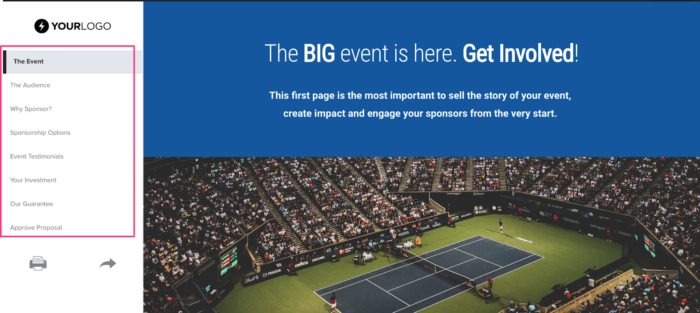
It’s fully customizable, and you can share or print it once you’re done customizing it.
Here’s a proposal template from PandaDoc. If you’re planning a music event that needs sponsors, this is a great template to use.
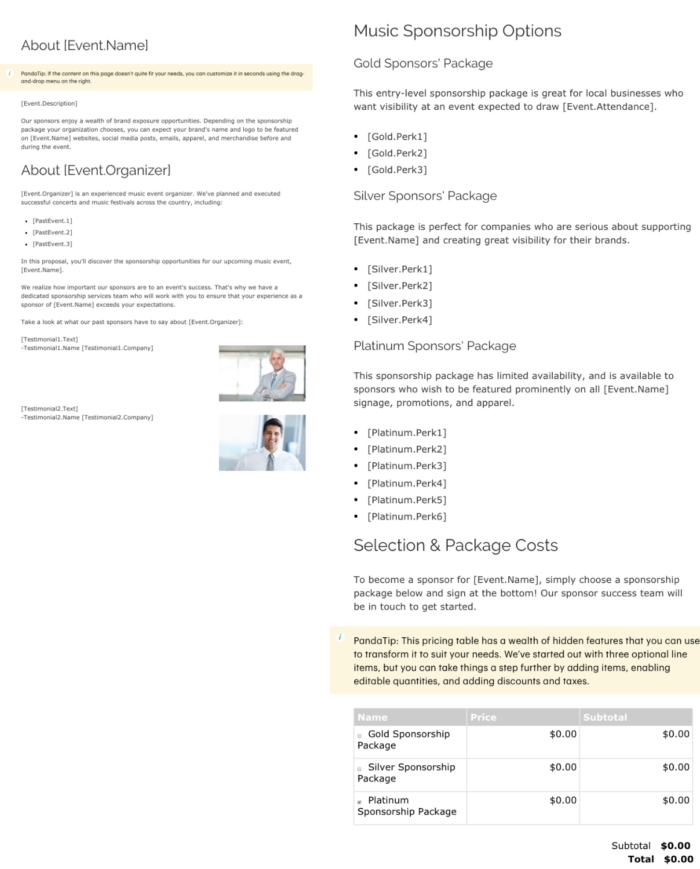
The template is focused on the sponsor — which is awesome. Notably, it has a section called “Music Sponsorship Options,” which gives potential sponsors or partners multiple options to choose from, instead of just one.
Here’s a sponsorship proposal for charity events that’s focused on the benefits sponsors get from your event:
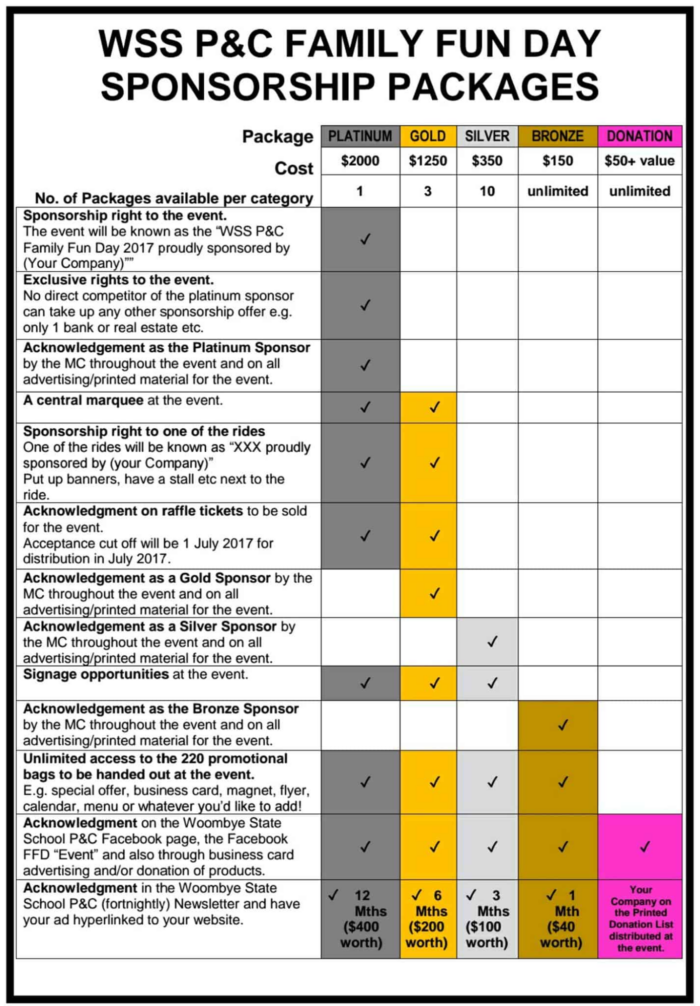
The first column has all the details about the different options for sponsoring your charity event. The sponsor can pick whichever options suit their budget and preferences.
This is another template from PandaDoc, detailing everything a potential sponsor needs to know about partnering on a sports event:
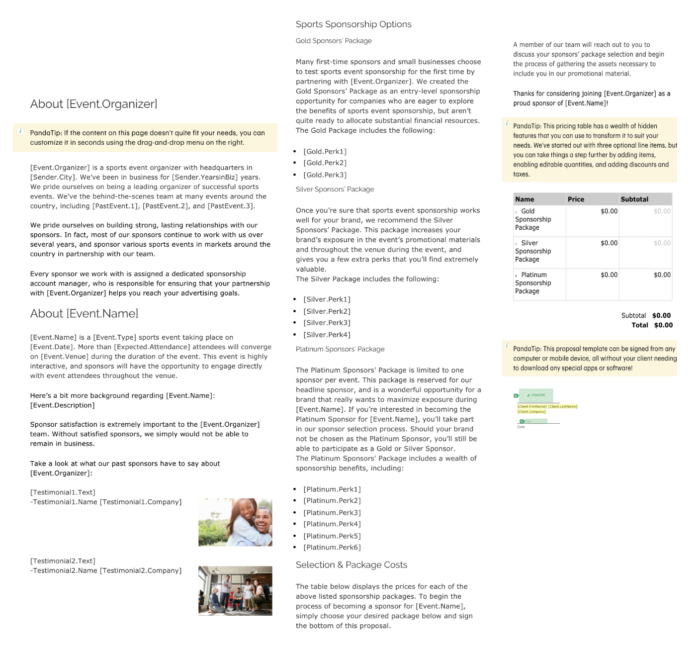
This one is a bit different from the music event sponsorship template; it has longer descriptions about the event organizer, the event name, and each sponsorship package. That helps to beef things up for potential sponsors.
Creating an event branding strategy
The first things that probably cross your mind when you think about event branding are flyers, bags, and posters — all sporting the same colors and designs.
That’s true about branding, but it’s only half the story. The other half is what event attendees remember about your event. Whatever they remember (be it good or bad) defines your event brand.
Lucidpress put it this way: “A brand is the sum total of impressions a customer has, based on every interaction they have had with you, your company and your products.” For example, if they remember that “get started” is the main takeaway from your event, then that’s one major element that defines your brand.
Or if they remember that, besides the “get started” slogan, yellow was the predominant or most noticeable color in your event — from the event notification email they got the morning before attending your event to your stage props color — then “yellow” is a key part of your brand as well.
Another example: What do you remember when you hear, “Just do it”? Nike. That catchphrase represents Nike’s brand because that’s what they’ve centered their events and campaigns on for years.
Below are five branding strategies you can use for any event.
Decide what you want attendees to remember
You want attendees to have good memories about your event, but you need to specifically define what those are:
- Do you want them to talk about your colorful stage or ambiance?
- What color represents the event better than others? (Color increases brand recognition by up to 80 percent.)
- What’s the distinct trait they should remember about your ushers? You can have them wear unique uniforms that probably aren’t used at other events.
- Is there a side attraction your attendees would love? Would a specific artist increase the memorability of your event? If there’s a musician, comedian, or speaker you know your attendees like, it’s a great idea to invite them.
These are just a few of the many things you can do to make attendees remember your event. Brainstorm with your team about other ways to create things your attendees will remember for a long time.
Create an event landing page
An event landing page is where potential event attendees can learn more about your event and register for it.
While building your event landing page, here are important factors to consider:
- Make registration the only call to action (CTA) on your landing page. This means your attendees won’t have to choose between registering or responding to another CTA on the page.
- Use video. If you’re able to, use videos on your event landing page to explain what your event is about. This alone can improve your registrations by 80 percent.
- Write good copy. Ensure the text on your landing page that persuades people to register for your event is great. If you’re not good at writing persuasive copy, hire an expert.
Create an event hashtag
Generally, you need to use an event hashtag that
- Attendees can easily remember
- Makes attendees remember your client’s brand or product — for example, if you’re planning an event for a brand called Lavita, use a hashtag that mentions the brand, like #LavitaConference or their product; think “Inbound#19”
- Is short (people are more likely to remember terms when they’re short)
Create a social wall
A social wall is a screen or “digital wall” that displays social media posts about your event.
You may have seen a social wall at an event you attended so you probably know what it looks like, but if not, here you go:
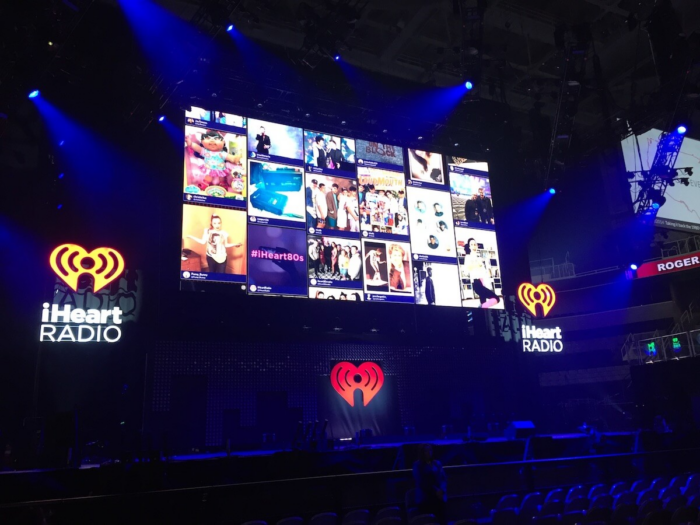
Usually, the posts in a social wall come from social media posts that have your event hashtag in them.
Brand your emails
Last but not least, you need to brand your emails. By now, you’ve probably heard that half of the world’s population (3.7 billion people) uses email. So you know how important crafting well-designed emails is for your event.
Brand your emails with one color that transcends your event. Settle on a color that people can associate with your event, and use it everywhere — from your event marketing emails to your reminder emails.
You also need good copywriting skills to convince people to open your emails and click through the CTA(s) in them to register.
Branding management/solutions
Here are five event branding solutions that will make it easier to manage your brand:
Hashtag analytics tool
Hashtag analytics tools like Keyhole, Brand24, and Sprout Social help you monitor your event brand. These tools show you
- What people are saying about your event
- The demographics of the people talking about it
- The percentage of positive, neutral, and negative sentiments (e.g., 50 percent of attendees post nice things about your event, 30 percent are indifferent, and 20 percent are angry)
- How many influencers are talking about your event and who they are
- In general, how many posts, impressions, and like data your event gathered; here’s how that looks on Keyhole, for instance:
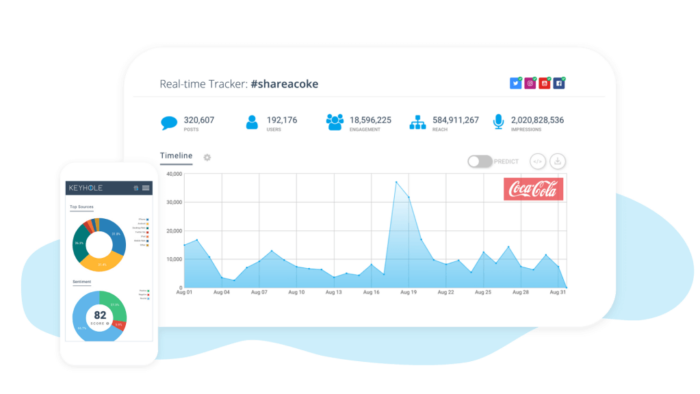
Design tools
Design tools like Canva, PicMonkey, Venngage, and Piktochart are powerful.
They can help you design flyers, logos, and most other materials you need to market your event or engage with attendees.
As with anything else, if you’re confident you have the time and ability to design, go for it. But if you lack design skills, hire a designer to help you out.
Video tools
If you’re handling video yourself, the following tools can help you:
- Animoto helps you create videos from photos, illustrations, video clips, and music. Animoto helps you mix media materials together to produce professional-looking videos.
- Vimeo helps you bake your brand colors into video, add your logo, choose the perfect thumbnail, remove the playbar, add speed controls, and more. Vimeo also helps you invite your event team on video creation projects so everyone gets to collaborate and make suggestions before your final video is ready.
- Doodly helps you make whiteboard, blackboard, and greenboard videos. You can also use any custom board color you want.
Wistia provides simple software for creating, managing, and sharing your event videos. You also get analytics on who views your videos and how long they view them.
Creating an event marketing and promotion plan
The stronger your event marketing plan, the more attendees you attract.
And regardless of how popular an event has been in the past, you still need a marketing plan to keep it successful.
Take the Super Bowl, for example. It’s the NFL’s biggest event, so why wouldn’t it be successful?
Regardless of their years of success, the NFL still runs marketing campaigns to promote the Super Bowl. You see influencers posting and raving about the event, and the NFL runs ads on every platform under the sun. You’d have to be living under a rock not to hear about the Super Bowl.
So remember, regardless of your event type or size, you need an event marketing plan.
Types of event promotion
Here are four ways to promote your event:
Use engaging influencers
Develop email list partnerships
Place social media ads
Produce flyers (and other offline media)
A total of 49 percent of consumers depend on influencer recommendations. This means your audience is more likely to attend your event when it’s promoted by an influencer they know and love.
But ensure you’re using influencers with high engagement (likes, comments, and repost) rates.
There are brands, bloggers, and other movers and shakers that have email lists of potential attendees who are highly engaged. You can partner with them and promote your event to their contacts.
Since it’s a partnership, you’ll need to offer them incentives.
And choose partners who not only have thousands of subscribers but very engaged ones. An engaged list means more potential engagement with your event, which means more potential attendees.
If you’re not a social media advertising expert, you might have to hire one. These ads can easily waste your money, especially if you have no idea how to do social media advertising.
But social media ads can be extremely effective as well — Jotform’s founder, Aytekin Tank, once used a single Twitter ad to drive 17 million views. Imagine that number of views on your event ad; with the right offer on the event ad, you’ll sell out your event in no time.

t might look like the days of offline media have ended. The truth is, they haven’t.
Flyers, billboards, posters, road shows, ticket selling outlets, and speaking engagements at other events are still great channels through which you can effectively market.
Developing an event marketing/promotion strategy
Channels are only a tool to market your event. You need well thought-out strategies to successfully promote your event on any platform (be it social media, email lists, or other avenues).
Here are four powerful event promotion strategies:
1. Creating an event marketing and promotion plan.Research where potential attendees hang out. Find a tool that shows you how many potential attendees are online.
For example, if you’re planning an event for a business, talk to their marketing team. Ask them where most of their site visitors come from. Ask if they’ve run Facebook, Twitter, or any other type of ads, and if they know where most of their customers come from.
2. Show off your most influential speakers. Event attendees are usually drawn to specific speakers they admire. If you have speakers or artists your attendees love or look up to, include them in all of your promotional materials.
See how Inbound does it:
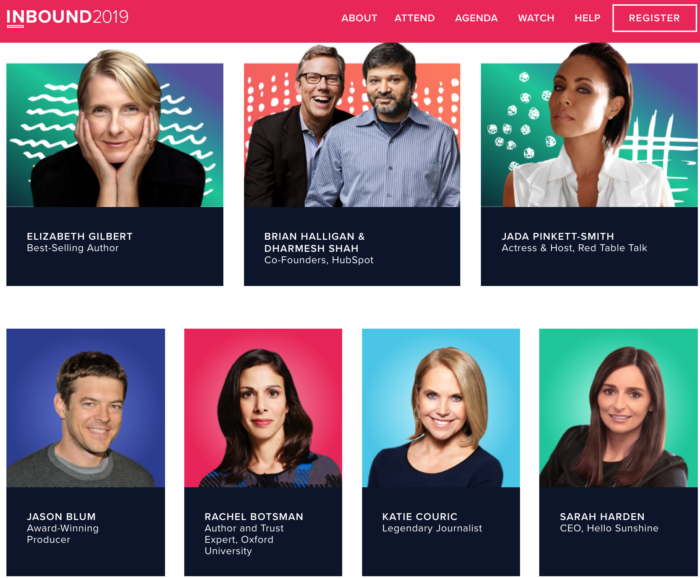
They feature their most influential speakers on their homepage. There’s a best-selling author, a popular actress, a TV host, and an award winning producer — all prominent in their industries. This builds anticipation for the event and encourages attendees to invite other people to attend.
3. Get people’s attention with video. Over 500 million (half a billion) people watch video on Facebook every day. And this isn’t the only stat that proves video draws people’s attention more than most other types of content or marketing.
When you use video on your event landing pages, website, and social media ads, you can captivate potential attendees with stories, authenticity, humor, and even weirdness.
One key advantage of using video to promote your event is that it gives you lots of bandwidth to be creative. Get wild and think of the craziest ideas that will attract people’s attention.
4. Testimonials. Testimonials work for the same reason influencer marketing does: People trust recommendations from people like them or folks they know. So use testimonials across your event marketing materials. They’ll shape how people look at your event and win their trust. If you can get them on video, even better! Video testimonials feel more personal and authentic and can create immediate connections.
Event promotion and marketing software, solutions, and platforms
Here are some event promotion software solutions to help you organize your marketing and get better results:
Chatbot software. People want a reply the minute they ask you a question. HubSpot research reveals that 71 percent of people who use messaging apps to get customer assistance do it because they want their problem solved fast.
They don’t want to fill out a form and wait hours for the answer. You need chatbot software tools in your event promotion arsenal. A few good chatbot options are Drift, Pure Chat, HubSpot Chatbot, and MobileMonkey.
Social media management software. You need technology that helps you organize interactions on social media about your event. These tools are great:
- Buffer helps you schedule posts and share them whenever you want. They also provide analytics, showing you the reach, impressions, links, comments, and shares your posts get.
- MeetEdgar is another tool that makes it easy to schedule and automate your content on Facebook, Twitter, Instagram, and LinkedIn. You also get reports on how your posts are performing so you can optimize them as you go.
- TweetDeck helps keep your tweets and hashtags organized. You can manage all Twitter interactions about your event from one central platform and easily engage with your attendees and others.
CRM software. You’re most likely going to be collecting your attendees’ names, emails, phone numbers, and location. This information is gold. You can use it to contact them about your next event or even sell them relevant products.
But you need a tool that will help you manage your interactions with them. Tools like HubSpot CRM, Pipedrive, and Salesforce are great options.
In general, while we’ve listed only three types of event marketing tools you’ll need, there are several others you might consider depending on your needs and goals. A simple Google search will provide you with a list of great tools.
For instance, you can search for “event landing page builder,” and you’ll get lots of options to choose from. Look through the list of recommended tools and pick the ones with features that best suit your needs.
Logistics
A million and one things can go wrong with your event. Here are five major event logistics tips to help curb any pre-event anxiety you might have:
1. Run security checks before scanning tickets. “It takes longer to do security checks than it does to scan tickets,” says Tommy Goodwin of Eventbrite. So it makes sense to let attendees go through the more time-consuming task (security checks) before the easier one (ticket scanning); it also helps to ensure attendees don’t experience a backup between the two stations.
2. Strategize your equipment needs. How many pieces of equipment are you bringing in? How large are they, and when are they coming in? Do they need to come into the venue the day before or by 6 a.m. on D-day?
3. Prepare for VIPs. If you have VIPs coming to your event, prepare ushers to bring them in and have a door or route ready for them as well as a good seat — preferably at the front of the room.
4. Strategize points of entry. Map out the different doors into your event room, hall, or space. Know the entry points for ushers, caterers, stage managers, technical people, and so on. “Each entry point helps alleviate traffic bottlenecks,” says Goodwin.
5. Set up routes and funnels. Understand what happens after every activity. For example, where do attendees go once they enter the facility? If they’re going straight to your check-in point, where do they go after that? Things can get rowdy fast if these seemingly little details aren’t set out in a funnel early on.
Event logistics solutions and services
Technology can ease a lot of the heavy lifting of event logistics. Here are five event logistics tech services you’ll need:
1. Online registration forms help you collect your attendees’ details easily. Jotform’s registration forms are great options.
2. Barcode ticket scanners like Ticket Tailor eliminate the stress of manually looking through a giant spreadsheet to cross off registered attendees.
Imagine how long it would take if you had to check in each attendee this way.
3. An electronic signature tool. For many events — especially the business-related ones — you might have to send documents to your attendees. It would be a nightmare to send documents to even a hundred attendees (let alone hundreds) and wait for all of them to sign each one and send them back to you.
You need a technology that streamlines your signing process. Dropbox Sign (formerly known as HelloSign) is commonly used for e-signatures, but Jotform’s E-Signature widget is even easier and more professional. It fits neatly into the layout of your form and allows recipients to instantly draw their signatures with a mouse or touch screen.
4. A tracking app. When you’re expecting some equipment to arrive at the venue, use a tracking app so you know where everything is at all times. You won’t have to be on your toes, constantly calling your carriers about the location of your equipment. Hubstaff is a great tracking app to use.
5. Walkie-talkies. Imagine you need to give a quick instruction to dozens of workers at your event. Would you prefer broadcasting the information to them all at once or calling each of them one after the other? Exactly. Don’t underestimate how often it’ll come in handy to reach everyone at once, before, during, and after the event. You’ll have to purchase or rent some extra equipment, but ultimately walkie-talkies are more reliable than using cell phones, so you don’t have to worry about reception issues or whether people are paying attention. One announcement is all it takes.
Conclusion
There you go! This guide contains the key things you need to know to become a great event planner. It covers the basics of event planning, getting your first few clients, putting together a meaningful event, and a lot of nitty-gritty you may not have considered. Consult this guide as you go, and you’ll find yourself checking boxes all the way to a successful event.






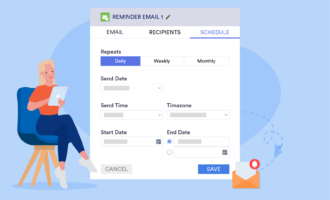





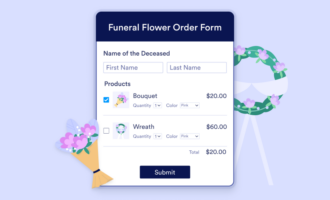

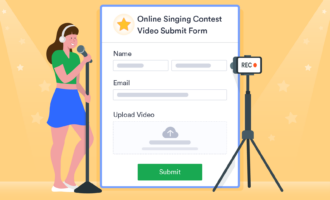



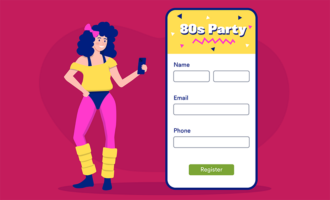













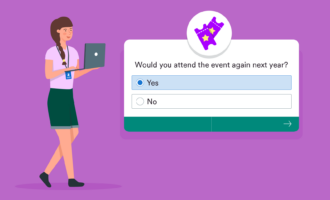


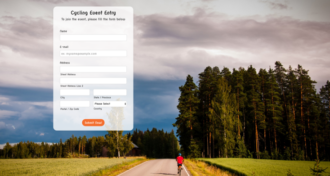



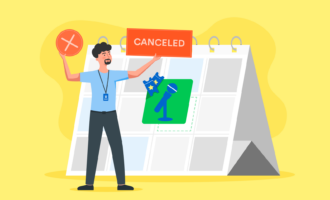



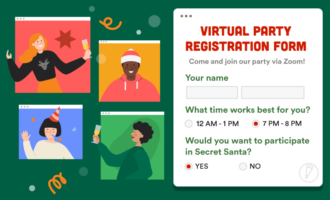








Send Comment:
2 Comments:
More than a year ago
Omg... so much information and I cannot see a simple button where I can finally build event selling page
More than a year ago
It's a fantastic list, both instructive and useful. I loved how you explained every single detail. Thank you!